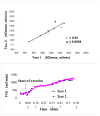Exercise intolerance
- PMID: 18313628
- PMCID: PMC2700357
- DOI: 10.1016/j.hfc.2007.12.002
Exercise intolerance
Abstract
Exercise intolerance is the primary symptom of chronic diastolic heart failure. It is part of the definition of heart failure and is intimately linked to its pathophysiology. Further, exercise intolerance affects the diagnosis and prognosis of heart failure. In addition, understanding the mechanisms of exercise intolerance can lead to developing and testing rational treatments for heart failure. This article focuses on the fundamental principles of exercise physiology and on the assessment, pathophysiology, and potential treatment of exercise intolerance in diastolic heart failure.
Figures














Republished in
-
Exercise intolerance.Cardiol Clin. 2011 Aug;29(3):461-77. doi: 10.1016/j.ccl.2011.06.002. Cardiol Clin. 2011. PMID: 21803233 Free PMC article.
References
-
- Gandhi SK, Powers JE, Fowle KM, Rankin KM, Nomeir AM, Kitzman DW, et al. The Pathogenesis of Acute Pulmonary Edema Associated with Hypertension. N Engl J Med. 2000;344(1):17–22. - PubMed
-
- Powers JE, Gandhi SK, Kramer RK, Fowle KM, Kitzman DW, Little WC. Predictors of Poor Outcome in Patients with Hypertensive Pulmonary Edema. J Am Coll Cardiol. 2004;43(5A):227A.
-
- Kitzman DW, Little WC, Brubaker PH, Anderson RT, Hundley WG, Marburger CT, et al. Pathophysiological characterization of isolated diastolic heart failure in comparison to systolic heart failure. JAMA. 2002;288(17):2144–2150. - PubMed
-
- Bol E, de Vries WR, Mosterd WL, Wielenga RP, Coats A. Cardiopulmonary exercise parameters in relation to all-cause mortality in patients with chronic heart failure. Int J Cardiol. 2000;72:255–263. - PubMed
-
- Jones RC, Francis GS, Lauer MS. Predictors of mortality in patients with heart failure and preserved systolic function in the Digitalis Investigation Group trial. J Am Coll Cardiol. 2004;44(5):1025–1029. - PubMed
Publication types
MeSH terms
Grants and funding
LinkOut - more resources
Full Text Sources
Other Literature Sources
Medical

